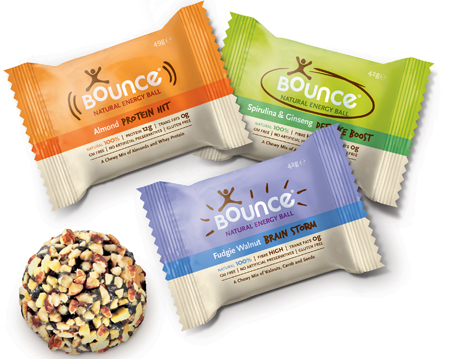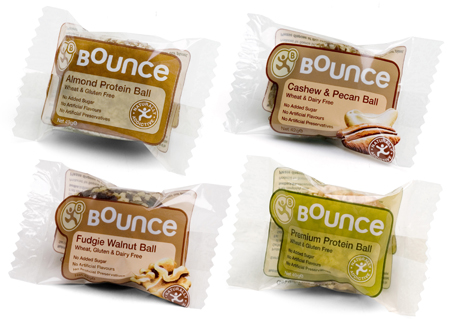In 2007, the then newly launched Bounce Balls were criticized in The Grocer, with the Expert Verdict (Category Controller, Nisa-Today) concluding: “The packaging is nondescript and doesn’t shout out to the consumer… the products will only appeal to the health-conscious. They are also too expensive… this is a niche product… the company will find it difficult to market this outside of health stores.”
Unphased, The Natural Brands Company, owners of the Bounce brand, pressed on, maintaining their price points, packaging and branding, and indeed achieving listings and sales in health food shops.
By 2009 Bounce was stuck in a rut. It seemed unable to generate the rapid growth an ambitious young brand needs without looking to change the core product offering. Biles Inc. was asked by The Natural Brands Company to redesign the packaging to make it more appealing to consumers, to drive sales, and to overcome resistance to listing; leading to new, and a wider variety of listings, and in turn opening the brand up to a wider audience. One year on and consumers now understand the benefits, and appreciate the value: outperformed the category 48 times over, £444k first year profit with the £12.5k design investment delivering £159k ROI in the first year. (Download teh full case study here).
Photo: The new design of Bounce Balls
Outline of Project Brief. Business objectives:
• Increase unit profit margins.
• Increase volume sales.
• Gain new listings with high street retailers.
• Achieve positioning in higher volume categories (outside of speciality health / technical nutrition).
• Attract new consumers outside of the speciality Health Shop sector.
• Drive new international listings.
Design & marketing objectives (the challenge):
To use packaging and branding to:
• Drive consumer appeal.
• Present a focused and appropriate consumer proposition (accessible, technical health benefits).
• Capture an appropriate positioning within a range of sub-categories (Health/Cereal Bars, Sports Nutrition, Free From).
• Clearly communicate the USP.
• Clearly communicate product benefits.
• Create shelf standout.
• Add value and better reflect the premium price point.
Photo: The old design of Bounce Balls
Description:
The Natural Brands Company came to us with their existing range of five flavours of Bounce Balls (healthy, high energy balls of nuts and protein, free from bad stuff, full of good stuff). These SKUs were primary packaged in plastic wrappers, and sold exclusively from either shelf ready packaging: boxes (for shelves) and tubs (for more prominent (impulse) positions or from branded POS units).
Overview of the Market:
The ‘Health Confectionery’ and ‘Snack Bar’ categories are heavily populated and consumers are confused. In a leading London Health Food chain, 68 separate product lines compete side by side for consumers’ attention. Most products are lower priced natural health bars (price per gram around 50-60% of Bounce Balls). Some consumers mistake the lower priced bars as healthy without realising that many are not a great deal better for them than sugar-laden confectionery, with some bars full of cheaper fillers like glucose syrup. The rate of growth in the healthy market snack bar category is decelerating compoundly by 50% YOY, with growth in 2010 down to just 2%.
Size of Design Budget: £12,500
This included
• design
• artwork
• product naming
• a straw-poll brand codes and a visual equity audit with 25 consumers
• competitive price audits of Tesco and Amazon.co.uk
Outline of Design Solution:
Straw-poll research carried out by Biles Inc. with 25 consumers reiterated The Grocer’s criticisms, of the existing packaging. Consumers didn’t recognise and value the brand’s benefits and proposition. Bounce wasn’t seen as premium, and the packaging was seen as technical, medical and lacking in emotional appeal, except to highly knowledgeable technical nutrition consumers. Therefore, the task was to develop packaging to make Bounce Balls more engaging, and to appeal to a wider audience; to increase perceived worth; and communicate attributes, benefits and the USP more clearly.
Results:
At London’s market trend setting Planet Organic chain, Bounce achieved:
– 38% market share of sales value (healthy confectionery & cereal bars)
– 30% market share sales by volume
– 90% growth YOY to May 2011
– Despite having 50% fewer SKUs than the competition, the value of bounce sales was 98.5% higher than the next best performing brand.
–The average sales value of each Bounce SKU is now 130% higher than the average sales value of the next best performing product range: £634 per SKU per month (5 Bounce SKUs) versus £275 per SKU per month (10 SKUs).
65% growth forecasted for year two since redesign, again without ATL support based on existing new orders received in the first two months of this, the second year since redesign.
Internationally, bounce balls have also found new homes (carried in over 1275 new stores overseas): Australia, Finland, Canada, India, Sweden & Iceland, and Norway.

